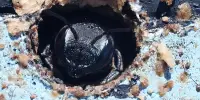Many creatures, most notably skinks, drop body parts to confuse predators, but some scorpions also lose their anus, which causes severe constipation. The scientists who posed the crucial question: What is the impact of arachnids being unable to lose their s*** on their ability to walk? have been awarded this year’s Ig Nobel prize for biology.
No animal gives up a body part easily, but lizards can regrow their tails after losing them, despite the excruciatingly lengthy time it takes. The sacrifice of shedding their tails is greater for scorpions. Dr. Solimary Garca-Hernández and Dr. Glauco Machado write in their prize-winning study, “Individuals lose about 25% of their body mass and the final piece of the digestive tract, including the anus, which hinders feces and leads to constipation, because regeneration does not occur.”
Some might wonder why any creature would make a sacrifice that prevents them from being able to eat regularly, but the writers demonstrate the kind of commitment that garners recognition like this by focusing on running capacity.
Another prize, for Art History, features the anus prominently (the Ig Nobels have never strictly adhered to the categories mentioned in Alfred Nobel’s will). The appropriately called team of Drs. Peter de Smet and Nicholas Hellmuth looked at what they think are images of ritual enemas being administered on old Maya ceramics. They came to the conclusion that the pictures showed alcohol and maybe psychedelic substances being delivered rectally and hypothesized that water lilies might cause hallucinations if consumed in this manner.
Amazingly, despite receiving only 12 citations from other scientific works during that time, this paper waited 36 years to receive the recognition it so richly deserves.
Anyone who sees the Ig Nobels as a celebration of the misuse of tax dollars might think about another study that has been waiting patiently for attention. Professor Gen Matsuzaki and colleagues investigated the most effective knob-turning technique in 1999. No, not the transformation of a repulsive individual into a beneficial member of society, but a real doorknob.
Although Matsuzaki claimed his award was for “working on a subject that no one cares about,” the discovery of the association between knob circumference and the ideal number of fingers to turn it has potential applications across our daily lives.
Even more significant was the study that discovered eating ice cream helps lessen a side effect of chemotherapy and was awarded the Medicine Prize. Although the authors felt they had to give the procedure a fancy name, “cryotherapy,” what counts is that future patients will not only experience fewer unpleasant and severe complications, but will also have their tastebuds treated.
The discovery that won the Applied Cardiology Prize: when people experience reciprocal romantic attraction their heart rates synchronize—could potentially be a $1 billion app.
Even what would initially appear to be sheer whimsy—two papers explaining why ducklings swim in a line—could end up being useful in shipping. One of the two winning papers on the subject’s original author, Professor Frank Fish, stated: “You’re not doing science if you’re not having fun.”
The Safety Engineering Prize-winning moose crash test dummy’s design and use may have more regionally restricted uses, but the authors provide helpful driving advice: swerve to get behind the moose’s tail, not in front of its head.
Even the Nobel Peace Prize was given out for scientific research, showing that when it comes to gossip, honesty isn’t always the best approach.
You can see the entire ceremony, replete with opera, scorpion models, awful duck puns, and victors receiving notes worth 10 trillion Zimbabwean dollars, below.
And the scorpion researchers, oh my! They discovered that scorpions of the species Ananteris balzani continued to move quickly even after their tails fell off. But over time, even when overfed, all the scorpion faeces filling up the digestive tube slowed the males but not the females. Make anything you want of that.















